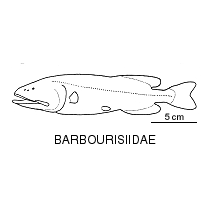- Classification
- ACTINOPTERYGII
- STEPHANOBERYCIFORMES
- BARBOURISIIDAE
-
Fish Classification
-
Class
ACTINOPTERYGII Ray-finned fishes -
Order
STEPHANOBERYCIFORMES Pricklefishes and allies -
Family
BARBOURISIIDAE Redvelvet Whalefish -
Genera
Barbourisia(1)
Family BARBOURISIIDAE
Moderately-sized reddish-orange fishes with a long robust, somewhat flabby body, a large head, a long snout, a very large mouth with jaws extending well beyond the small eye, and a single dorsal fin opposite the anal fin and far back on the body. The family contains a single species, Barbourisia rufa, found in meso- and bathypelagic waters worldwide.
More Info
|
Family Taxonomy |
A monotypic family containing Barbourisia rufa, the Redvelvet Whalefish. |
|
Family Distribution |
Originally described from the Gulf of Mexico, the meso- and bathypelagic Barbourisia rufa is known from tropical to temperate waters of the Atlantic, Pacific and Indian Oceans from >60°N to 45°S; Paxton et al. (2001) reports the capture depths with both benthic nets between 350 and 1500 m and pelagic nets to at least 800–2000 m. |
|
Family Description |
Meristic features: Dorsal fin 19-22; Anal fin 15-18; Pectoral fin 13-14; Pelvic fins 6; Caudal fin (principal rays) 19; Vertebrae 40-43. Body elongate, moderately robust; head large, with large mucous cavities on top of head separated by thick ridges and covered by skin; eyes small. Snout very long; nasal organ moderately developed. Mouth very large, jawsvery long, extending far behind eye. Teeth small, close set, present on jaws, vomer, and ectopterygoid; palatine and copula lacking teeth. Gill rakers well developed, lath-like. Fin spines absent; dorsal and anal fins opposite and far posterior; pelvic fins abdominal. Lateral line well developed as a broad tube pierced by small pores and supported by internal scales. Body and head covered in small, adherent, non-imbricate scales with a single, central spine giving a velvet-like texture. No photophores or luminous tissue. No cavernous tissue. Pleural ribs present. |
|
Family Size |
Maximum length 39 cm SL. |
|
Family Colour |
Bright reddish orange. |
|
Family Feeding |
Carnivores |
|
Family Reproduction |
The sexes are separate and fertilisation is presumably external. Larval development is direct. Paxton et al. (2001) desribed the larvae and juveniles. |
|
Family Commercial |
Of no interest to fisheries; occasionally taken in commercial trawls. |
|
Author |
John R. Paxton & Dianne J. Bray |
|
Family Resources |
Digital Fish Library - for 3D MRI images of Barbourisia rufa |
References
Kotlyar, A.N. 1995. Osteology and distribution of Barbourisia rufa (Barbourisiidae). Voprosy Ikhtiologii 35(3): 282–289. (In Russian, English transl. Journal of Ichthyology 35(6): 140-150.
Parr, A.E. l945. Barbourisidae, a new family of deep sea fishes. Copeia 1945(3): 127-129.
Rofen, R.R. l959. The whale-fishes: families Cetomimidae, Barbourisiidae and Rondeletiidae (order Cetunculi). Galathea Reports 1: 255-260.
Paxton, J.R. 1999 Barbourisiidae. Redvelvet whalefish. p. 2205. In: K.E. Carpenter, K.E. & V.H. Niem (eds). FAO species identification guide for fishery purposes. The living marine resources of the Western Central Pacific. Vol. 4. Bony fishes part 2 (Mugilidae to Carangidae). FAO, Rome.
Paxton, J.R., Johnson, G.D. & Trnski, T. 2001. Larvae and juveniles of the deepsea “Whalefishes” Barbourisia and Rondeletia (Stephanoberyciformes: Barbourisiidae, Rondeletiidae), with comments on family relationships. Records of the Australian Museum 53: 407-425.
Struhsaker, P. 1965. The whalefish Barbourisia rufa (Cetunculi) from waters off southeastern United States. Copeia 1965(3): 376–377.







